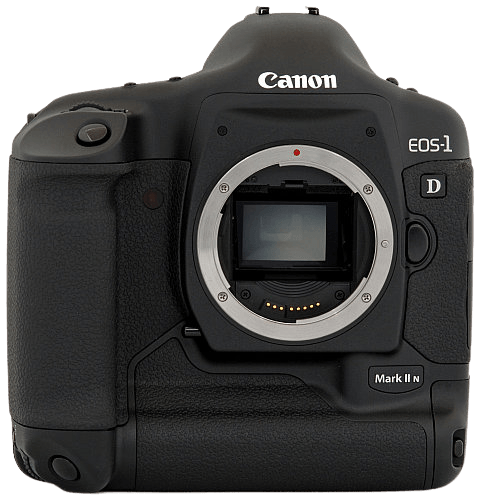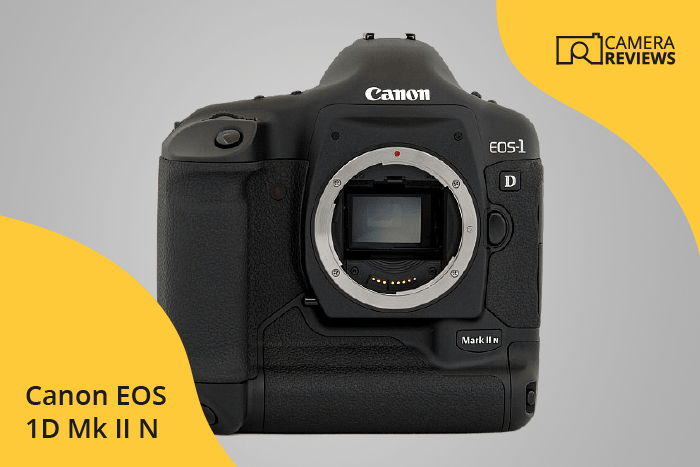Canon EOS 1D Mark II N Specs and Scores

The Canon EOS 1D Mark II N scored 40/100 in our evaluation. This DSLR camera, announced on August 22, 2005, and released the same year, had a launch price of $5986. Measuring 156 x 158 x 80mm and weighing 1565g (3.45lbs), the 1D Mark II N was a high-end option in its time. However, compared to today’s market, the specifications of this camera fall short, resulting in its lower score. Despite its past success, the Canon EOS 1D Mark II N is now considered outdated and lacks the advanced features found in more recent models.
Canon EOS 1D Mark II N Overview and Optics
The Canon EOS 1D Mark II N receives an optics score of 46/100. This camera features 8.2 megapixels, an APS-H CMOS sensor, and a Digic II processor. With a shooting speed of 8.5 frames per second, it allows for quick capture of images. The camera’s sensor holds a DXOMARK score of 66, which is a decent rating. The lens mount is Canon EF, providing compatibility with a wide range of lenses. However, the camera lacks image stabilization, which may affect image quality in certain situations. The aspect ratio is 3:2, a standard format for photography.
Comparing these specifications to today’s market, the Canon EOS 1D Mark II N falls short in certain areas, such as megapixels and image stabilization. Modern cameras often have higher megapixel counts and built-in image stabilization features, which can result in sharper images. Despite these shortcomings, the camera’s shooting speed and compatibility with various Canon EF lenses are still valuable assets for photographers.
Taking these factors into account, the Canon EOS 1D Mark II N may not be the top choice for those seeking cutting-edge optics. However, its compatibility with Canon EF lenses and fast shooting speed can still make it a viable option for some photographers, depending on their specific needs and preferences.
Canon EOS 1D Mark II N Video Performance
The Canon EOS 1D Mark II N does not possess video functionality. This camera focuses solely on photography without any video capabilities.
Canon EOS 1D Mark II N Features and Benefits
The Canon EOS 1D Mark II N receives a feature score of 17/100. This score might seem low for a camera, but it is essential to consider that this model was released in 2005. The camera’s specifications include a 2.5-inch screen with a resolution of 230,000 dots. However, it lacks modern amenities such as a touchscreen, flip screen, GPS, Wi-Fi, and Bluetooth connectivity.
Given the advancements in camera technology, the Canon EOS 1D Mark II N may not be the ideal choice for those seeking a camera with up-to-date features. Other models in the market offer higher resolution screens, touch capabilities, and wireless connectivity options. The absence of these features in the 1D Mark II N makes it less competitive in today’s market.
Despite its low feature score, the Canon EOS 1D Mark II N still holds value for those who appreciate its robust build and image quality. However, potential buyers should consider the lack of modern features before making a decision.
Canon EOS 1D Mark II N Storage and Battery
The Canon EOS 1D Mark II N receives a storage and battery score of 79/100. This camera offers two memory card slots, which accept both SD and Compact Flash (Type I or II) cards. This flexibility in memory card options is a benefit for photographers who need to manage multiple cards for more storage capacity.
Regarding battery performance, the EOS 1D Mark II N provides 1200 shots per charge with its NP-E3 battery type. However, this camera does not support USB charging. While the 1200-shot battery life is still impressive, the lack of USB charging may be inconvenient for some users, especially when compared to more recent models offering this feature.
Taking these factors into account, the Canon EOS 1D Mark II N holds up well in the storage and battery department, but there is room for improvement in terms of charging convenience.
Canon EOS 1D Mark II N Alternatives
Do you want to know how the Canon EOS 1D Mark II N compares to its competitors? Have a look at the most popular comparisons for this camera below:
- Canon EOS 1D Mark II N vs EOS 1D Mark III
- Canon EOS 1D Mark II N vs EOS 1D Mark IV
- Canon 1D C vs EOS 1D Mark II N
- Canon EOS 1D Mark II N vs EOS 1Ds Mark III
- Canon EOS 90D vs EOS 1D Mark II N
- Canon EOS 1D Mark II N vs EOS 1D X Mark III
Canon EOS 1D Mark II N FAQ
Does the Canon EOS 1D Mark II N Have Built-in Image Stabilization?
The Canon EOS 1D Mark II N does not have built-in image stabilization. However, it is compatible with Canon lenses that feature image stabilization, which can help reduce camera shake.
Does the Canon EOS 1D Mark II N Support 4K Video Recording?
The Canon EOS 1D Mark II N does not support 4K video recording as it does not have video functionality at all. It is primarily designed for professional still photography.
What Size Sensor Does The Canon EOS 1D Mark II N Have?
The Canon EOS 1D Mark II N features an APS-H sized sensor, which is larger than the APS-C sensors found in many DSLRs but smaller than a full-frame sensor.
Does the Canon EOS 1D Mark II N Have a Dual Memory Card Slot?
Yes, the Canon EOS 1D Mark II N has a dual memory card slot, supporting both CompactFlash and Secure Digital (SD) cards, allowing for increased storage capacity and flexibility.
Does the Canon EOS 1D Mark II N Have a Touch Screen?
No, the Canon EOS 1D Mark II N does not have a touch screen. Its rear display is a 2.5-inch LCD screen with a resolution of 230,000 dots for reviewing images and navigating menus.
Does the Canon EOS 1D Mark II N Have Wi-Fi and Bluetooth?
The Canon EOS 1D Mark II N does not have built-in Wi-Fi or Bluetooth capabilities. However, you can use external accessories to add these functionalities if needed.
Does the Canon EOS 1D Mark II N Have GPS?
No, the Canon EOS 1D Mark II N does not have built-in GPS. But, you can use external GPS accessories for geotagging your images if needed.
Is the Canon EOS 1D Mark II N Weather Sealed?
The Canon EOS 1D Mark II N is not fully weather-sealed, but it does have a durable magnesium alloy body and some weather-resistant features, making it suitable for use in various conditions.
Does the Canon EOS 1D Mark II N Have a Built-in Flash?
No, the Canon EOS 1D Mark II N does not have a built-in flash. However, it is compatible with a wide range of external flash units through its hot shoe and PC sync port.

